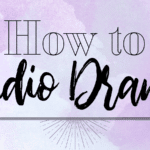How to Audio Drama 202: Fiction Podcast Marketing

Once you’ve made your audio drama, the next big hurdle is getting people to listen: marketing. You can’t rely on people stumbling across the show in their podcast apps to grow your audience – you’ve got to share your show. So, let’s talk about how to do that.
There are a million different social media websites that you could promote your podcast on. But if you’re like me, you’re one person making your audio drama and you don’t have time to post on twitter/facebook/instagram/reddit/tumblr/tiktock/etc every day all the time. Just typing that out was exhausting! I recommend that you pick and choose which social media to post on based on which websites you use and where you expect your audience to be. I use Twitter to promote my shows because that’s what I personally use a lot. I understand how the website works, so it’s easy to use. I also have Instagram accounts for my shows, but I don’t post as often on there – usually only for episode drops and milestones.
But something that’s important to remember is that audio dramas and fiction podcasts are evergreen. Episodes don’t need to be new to be relevant, interesting, or valid. You don’t need to only promote your latest episode, you can (and should!) share old episodes too. There’s always going to be people who’ve just found your show, and content that’s old to you will be new and exciting to them.
The bulk of this article will focus on social media marketing, but there’s other avenues as well. Doing cross promos with other audio dramas may be the best way to gain listeners. Ideally, you should have some audience overlap in shows you cross-promo with (beyond “they’re both fiction shows”). Trailer swaps or even cross-feed full episode drops are both great ways for people to discover your show while listening to podcasts.
Additionally, sending press releases for important milestones (or publicising those milestones on places like Fiction Podcast Weekly) is another way to share your show. Create a press kit to send out alongside these releases, and link it on your website for critics to easily find.
But when promoting your audio drama on social media, you should have an account for your show. This helps you build a brand for your show – one that doesn’t have to compete with the brand of a network account or your own.
It’s important to know who your audience is. What type of person listens to your show? Who is it made for? (I promise your audience isn’t everybody!) When you promote your podcast, you should be working to market it to that type of person. You should also avoid shoving your show in people’s faces. Don’t just drop a link and run – engage with potential listeners.
Here are some of my favorite tweets from audio dramas:
Read more: Why Isn’t Anyone Marketing Podcasts Correctly?
I’ve noticed that audio dramas who create visuals for their show are more successful on social media. They get more engagement and more followers. It’s easier to catch people’s eyes with fun graphics, and you can tell a lot about the aesthetic of a show from them. These can be mood boards, in-universe visuals, or even episode-specific cover art. In regards to the latter – most podcast hosts allow you to upload separate cover art for your episodes, and most podcast apps display that cover art alongside the episode. You can make your feed more visually interesting with episode cover art, and as a bonus, you can post that art on social media too.
A view of two shows on Spotify – one that I’ve added episode cover art to, and one that I haven’t.
I use Canva for creating graphics. It’s easy to use, and they have lots of built-in fonts, templates, and art you can pull from for creations. I’ve used Canva for everything from cover art and mood boards to memes and shit posts. Not everything you post needs to be super serious!
Here are some of my favorite graphics:
(Okay look, I know I made this one, but I did spend way too long laughing at my computer about it. Sometimes you gotta have fun marketing your podcast).
The visuals you post don’t all have to be fancy graphics. You can share screenshots of your DAW during sound design, pictures from recording sessions, and even lines from scripts as you write. As a creator, I love to see what’s happening behind the scenes on other shows, and as a fan, I love getting a teaser for what will be in my podcatcher soon.
You can also create and share clips from the episodes themselves. Headliner is a fantastic app for doing this – you can even add captions so someone can follow without turning the sound on. Frankly, you should add captions anyway because they’re an important accessibility feature! Part of good marketing is not restricting who can access your content. (Editor’s note: This also means using alt text for all marketing images!)
When you share episodes on social media, give a direct link to listen. There are websites like Kite and Chartable that will generate a link that when clicked, gives you options for where to listen.
And the same goes for promoting merch, crowdfunding links, or your Patreon. You want to reduce the number of clicks people have to do to engage with what you post. Don’t make them search you up in a podcast app, or Google your Teepublic store, or scour your website for a Patreon link.
Speaking of your website – have one! It doesn’t need to be fancy or complicated, but it needs to have all the information about your show in one place. When people google your show name, ideally your website is the first hit.
You should also put your website link in your social media bios, alongside a sentence description of your show. Check out Caravan’s twitter profile for a great example of this. Also, if you’re on twitter, consider pinning a tweet about the show to your profile. For a great example, check out Desperado’s pinned tweet. (On instagram, you can use the story highlights feature in a similar way). You want to make it so that newcomers to the show can see what it’s about from your profile alone. Make it easy to find and learn about your podcast.
The more you use social media, the more your followers (and interaction) will grow. But don’t worry about posting every single day. Share when you have something interesting to share! What you post doesn’t have to be about your podcast, but it should be related to the topic of your podcast.
Marketing can be a full time job, but it doesn’t have to be. If you’ve got multiple accounts for multiple shows (or even just one account for one show), it’s not usually feasible to post every day – and that’s alright! More often than not, numbers are a vanity metric. I’d suggest picking one thing that’s important to you (ex: I want 500 twitter followers before this season releases), and pushing for that. If you get overwhelmed on social media, consider making a spreadsheet to track posts, or schedule tweets ahead of time.
Ultimately, share your show when you want to share it. If you need to hang up the marketing hat for a bit? I’m giving you permission. Your show is always growing by word of mouth, and that can happen while you take a break, too.
You’ve got this. Good luck!












Comments
Comments are closed.